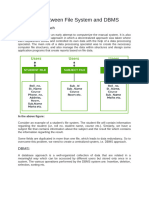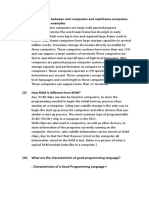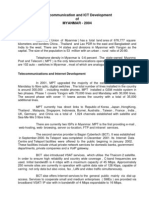ADP-IV- Database-DBMS vs File based -Database Architecture
Uploaded by
Ch UzairADP-IV- Database-DBMS vs File based -Database Architecture
Uploaded by
Ch UzairADP
Subject: Database System
Semester 4th Lecture #2
Date: 25/7/2024 Mid Term
Topic: Database Approach vs File based
System
Difference between File System and DBMS
Basics File System DBMS
The file system is a
way of arranging the DBMS is software for
files in a storage managing the
medium within a database.
Structure computer.
Redundant data can be
In DBMS there is no
Data present in a file
redundant data.
Redundancy system.
It doesn’t provide It provides in house
Inbuilt mechanism for tools for backup and
Backup and backup and recovery recovery of data even if
Recovery of data if it is lost. it is lost.
Query There is no efficient Efficient query
processing query processing in processing is there in
Basics File System DBMS
the file system. DBMS.
There is more data
There is less data
consistency because of
consistency in the file
the process of
system.
Consistency normalization.
It is less complex as It has more complexity
compared to DBMS. in handling as
compared to the file
Complexity system.
DBMS has more
File systems provide
security mechanisms as
less security in
Security compared to file
comparison to DBMS.
Constraints systems.
It has a comparatively
It is less expensive
Cost higher cost than a file
than DBMS.
system.
Examples Cobol,C++ Oracle,SQL Server
What is database architecture?
The term “database architecture” refers to the structural design and methodology
of a database System, which forms the core of a Database Management System
(DBMS). This architecture Dictates how data is stored, organized, and retrieved,
playing a crucial role in the efficiency and Effectiveness of data management.
Database architecture describes how a database management system (DBMS) will
be integrated With your application. When designing a database architecture, you
will make decisions that will Change how your applications are created. The
primary functions of a DBMS include data storage, retrieval, updating, and
management of Database security. It should provide a convenient and efficient
way to define, create, manage, and Control access to the database.
Types of database architecture models
The most common models include:
One-tier architecture
In one-tier architecture, the database, user interface, and application logic all
reside on the same machine or server. It's typically used for small-scale
applications where simplicity and cost-effectiveness are priorities. Because there
are no network delays involved, this type of tier architecture is generally a fast
way to access data.
On a single-tier application, the application and database reside on the same
device.
An example of a one-tier architecture would be a mobile application that
uses Realm, the open-source mobile database by MongoDB, as a local database.
In that case, both the application and the database are running on the user’s
mobile device.
Two-tier architecture
Two-tier architecture consists of multiple clients connecting directly to the
database. This tier architecture is also known as client-server architecture.
In a two-tier architecture, clients are connecting directly to a database.
This tier architecture used to be more common when a desktop application would
connect to a single database hosted on an on-premise database server — for
example, an in-house customer relationship management (CRM) that connects to
an Access database.
Three-tier architecture
Most modern web applications use a three-tier architecture. In this architecture,
the clients connect to a back end, which in turn connects to the database. Using
this approach has many benefits:
Security: Keeping the database connection open to a single back end
reduces the risks of being hacked.
Scalability: Because each layer operates independently, it is easier to
scale parts of the application.
Faster deployment: Having multiple tiers makes it easier to have a
separation of concerns and to follow cloud-native best practices,
including better continuous delivery processes.
In a three-tier architecture, the information between the database and the clients
is relayed by a back-end server.
An example of this type of architecture would be a React application that connects
to a Node.js back end. The Node.js back end processes the requests and fetches
the necessary information from a database such as MongoDB Atlas, using
the native driver. This architecture is described in greater detail in the next
section.
You might also like
- Cyber Recovery Workshop 2024 - CyberSense Troubleshooting, Trending Issues, Tips and TricksNo ratings yetCyber Recovery Workshop 2024 - CyberSense Troubleshooting, Trending Issues, Tips and Tricks42 pages
- Engineering Experience - Example 2 - The P.Eng. ApplicantNo ratings yetEngineering Experience - Example 2 - The P.Eng. Applicant12 pages
- (DBMS Concepts and Architecture) - 26-04-2023No ratings yet(DBMS Concepts and Architecture) - 26-04-20238 pages
- DBMS U 1 ONE SHOT Revision Notes_232012e6 92a0 4dc3 a350 2b8ff3383f23No ratings yetDBMS U 1 ONE SHOT Revision Notes_232012e6 92a0 4dc3 a350 2b8ff3383f23171 pages
- Aligarh Muslim University: Submitted By: Ghazala FarooquiNo ratings yetAligarh Muslim University: Submitted By: Ghazala Farooqui17 pages
- A211 - MTD3033 Assignment 1 Concept (Group)No ratings yetA211 - MTD3033 Assignment 1 Concept (Group)11 pages
- Chapter 1 Introduction to Database SystemsNo ratings yetChapter 1 Introduction to Database Systems36 pages
- ADP (D.S.) Equivalence Relations and PartitionNo ratings yetADP (D.S.) Equivalence Relations and Partition4 pages
- Project Synopsis On Encryption AlgorithmsNo ratings yetProject Synopsis On Encryption Algorithms15 pages
- Benchmark Gensuite International Launch - Quick Start GuideNo ratings yetBenchmark Gensuite International Launch - Quick Start Guide42 pages
- DBMAN284 With Queries RSRV Check of Time Dimension NegativeNo ratings yetDBMAN284 With Queries RSRV Check of Time Dimension Negative2 pages
- Monitoring, Managing, and Recovering AD DSNo ratings yetMonitoring, Managing, and Recovering AD DS26 pages
- Telecommunication and ICT Development of Myanmar 2004No ratings yetTelecommunication and ICT Development of Myanmar 20043 pages
- Information Technology Vocabulary For IELTSNo ratings yetInformation Technology Vocabulary For IELTS12 pages
- Principles of Operating Systems and Its ApplicationsNo ratings yetPrinciples of Operating Systems and Its Applications7 pages
- Bahria University (Karachi Campus) : Human Computer Interaction (SEN-320)No ratings yetBahria University (Karachi Campus) : Human Computer Interaction (SEN-320)2 pages
- Sankirthan Raj Mavella - Full Stack Java DeveloperNo ratings yetSankirthan Raj Mavella - Full Stack Java Developer6 pages
- Customer Experience and the IoT in Retail _ Verizon BusinessNo ratings yetCustomer Experience and the IoT in Retail _ Verizon Business4 pages
- Elo For Sharepoint: More Functionality For Greater EffectivenessNo ratings yetElo For Sharepoint: More Functionality For Greater Effectiveness8 pages
- Cyber Recovery Workshop 2024 - CyberSense Troubleshooting, Trending Issues, Tips and TricksCyber Recovery Workshop 2024 - CyberSense Troubleshooting, Trending Issues, Tips and Tricks
- Engineering Experience - Example 2 - The P.Eng. ApplicantEngineering Experience - Example 2 - The P.Eng. Applicant
- DBMS U 1 ONE SHOT Revision Notes_232012e6 92a0 4dc3 a350 2b8ff3383f23DBMS U 1 ONE SHOT Revision Notes_232012e6 92a0 4dc3 a350 2b8ff3383f23
- Aligarh Muslim University: Submitted By: Ghazala FarooquiAligarh Muslim University: Submitted By: Ghazala Farooqui
- DBMS MASTER: Become Pro in Database Management SystemFrom EverandDBMS MASTER: Become Pro in Database Management System
- Benchmark Gensuite International Launch - Quick Start GuideBenchmark Gensuite International Launch - Quick Start Guide
- DBMAN284 With Queries RSRV Check of Time Dimension NegativeDBMAN284 With Queries RSRV Check of Time Dimension Negative
- Telecommunication and ICT Development of Myanmar 2004Telecommunication and ICT Development of Myanmar 2004
- Principles of Operating Systems and Its ApplicationsPrinciples of Operating Systems and Its Applications
- Bahria University (Karachi Campus) : Human Computer Interaction (SEN-320)Bahria University (Karachi Campus) : Human Computer Interaction (SEN-320)
- Sankirthan Raj Mavella - Full Stack Java DeveloperSankirthan Raj Mavella - Full Stack Java Developer
- Customer Experience and the IoT in Retail _ Verizon BusinessCustomer Experience and the IoT in Retail _ Verizon Business
- Elo For Sharepoint: More Functionality For Greater EffectivenessElo For Sharepoint: More Functionality For Greater Effectiveness































































































